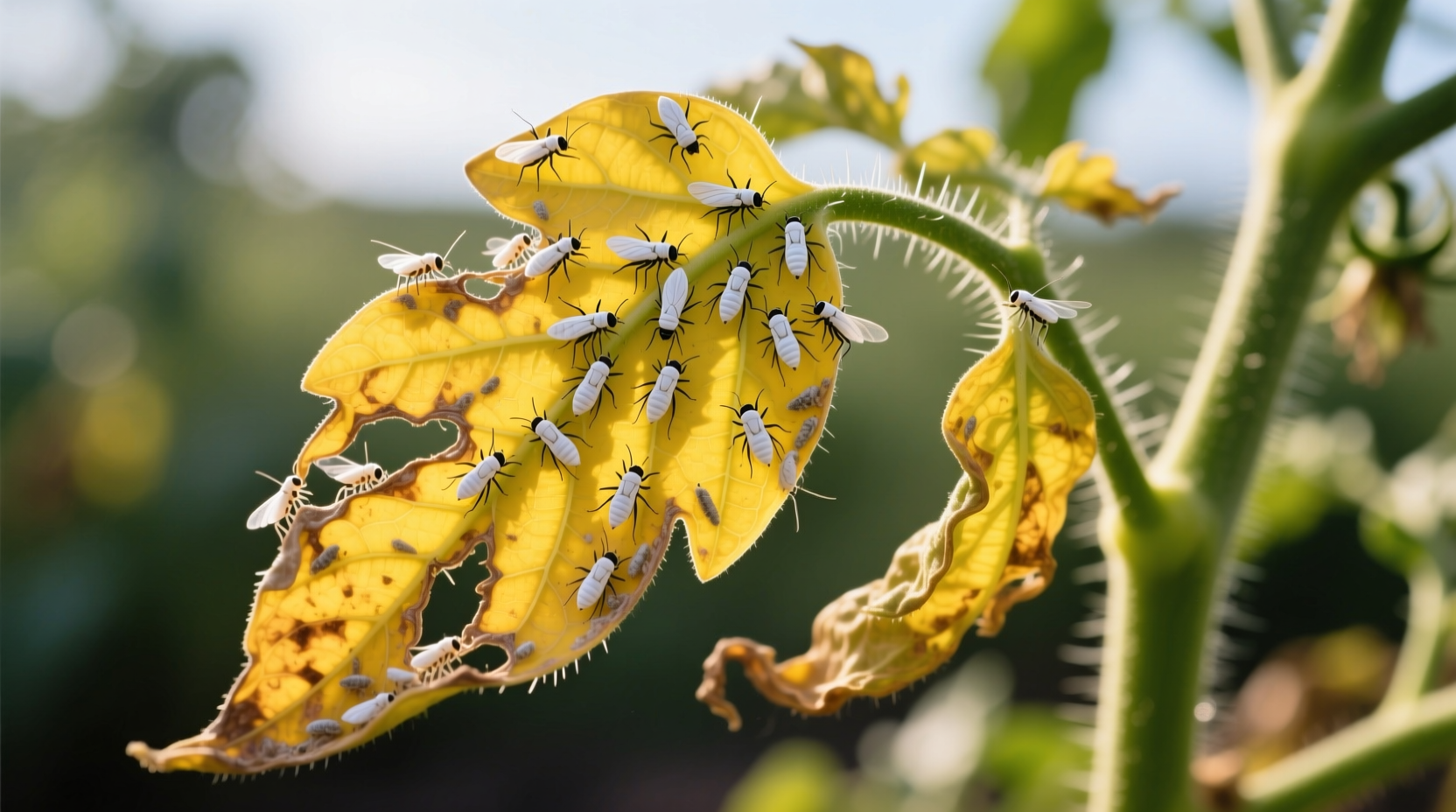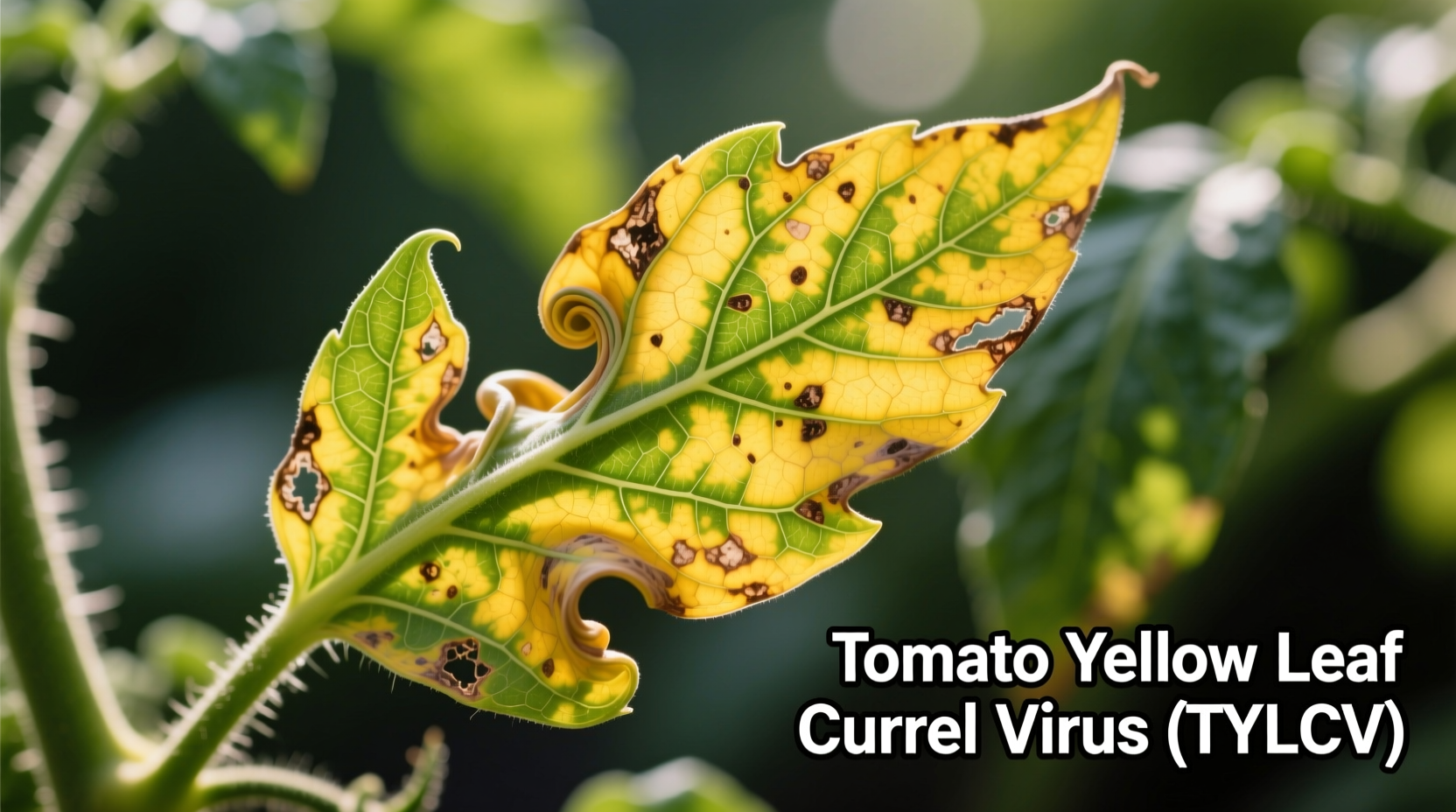Discover exactly how to identify tomato yellow leaf curl virus symptoms, understand its whitefly transmission cycle, and implement science-backed prevention strategies that actually work. This guide delivers actionable steps you need to protect your tomato plants before irreversible damage occurs.
How to Identify Tomato Yellow Leaf Curl Virus Symptoms
TYLCV produces unmistakable visual symptoms that distinguish it from other tomato disorders. Within 2-3 weeks of infection, you'll notice these key indicators:
- Young leaves curling upward with yellow margins
- Severe stunting of new growth and overall plant size
- Reduced flowering and fruit set
- Leaves becoming thickened and leathery in texture
- Interveinal yellowing progressing to complete yellowing
Unlike nutrient deficiencies that affect older leaves first, TYLCV symptoms appear on newer growth. The distinctive upward curling combined with yellow margins creates a unique visual signature that helps differentiate it from other common tomato issues.
| Condition | Leaf Curl Direction | Yellowing Pattern | Stunting Severity |
|---|---|---|---|
| Tomato Yellow Leaf Curl Virus | Upward | Margins first, then complete | Severe |
| Water Stress | Downward | General wilting | Moderate |
| Magnesium Deficiency | None | Interveinal on older leaves | Mild |
| Herbicide Damage | Variable | Necrotic spots | Variable |
This comparison helps eliminate common misdiagnoses when assessing your tomato plants. The University of California Agriculture and Natural Resources confirms that upward leaf curl with yellow margins represents the most reliable visual indicator of TYLCV infection (UC ANR).
Understanding TYLCV Transmission: The Whitefly Connection
Tomato yellow leaf curl virus spreads exclusively through the silverleaf whitefly (Bemisia tabaci). These tiny insects transmit the virus in a persistent, circulative manner:
- Whiteflies acquire the virus by feeding on infected plants for 15-30 minutes
- Virus circulates through the insect's body over 2-3 weeks
- Infected whiteflies then transmit TYLCV to healthy plants during subsequent feedings
- Each infected whitefly remains capable of transmission for its entire lifespan
The Texas A&M AgriLife Extension Service documents that a single infected whitefly can transmit the virus to multiple plants, making early detection critical (Texas A&M AgriLife). Unlike mechanical transmission methods, TYLCV cannot spread through tools, hands, or plant contact—only through whitefly vectors.
Proven Prevention Strategies for Tomato Growers
Since no cure exists for TYLCV once plants are infected, prevention represents your only effective defense. Implement these science-backed measures before planting:
Physical Barriers and Cultural Practices
- Install 30-50% shade cloth or insect-proof netting (0.4mm mesh) over plants
- Use reflective mulches (aluminum or silver) to deter whitefly landing
- Remove weed hosts like nightshade and cheeseweed that harbor the virus
- Practice strict crop rotation with non-host plants for at least 2 years
Whitefly Population Management
Effective whitefly control requires an integrated approach:
- Monitor weekly with yellow sticky traps placed just above canopy level
- Apply insecticidal soaps or neem oil at first sign of whiteflies (early morning)
- Introduce natural predators like Encarsia formosa parasitic wasps
- Remove and destroy heavily infested plants immediately
The University of Florida IFAS Extension emphasizes that whitefly control must begin early in the season before populations establish (UF IFAS). Once whiteflies reach threshold levels, TYLCV transmission becomes almost inevitable.
TYLCV Infection Timeline: What to Expect
Understanding the progression of TYLCV helps determine intervention points:
- Days 1-7: Whitefly feeding introduces virus; no visible symptoms
- Days 8-14: Initial upward leaf curling on newest growth appears
- Days 15-21: Yellow margins develop, stunting becomes noticeable
- Days 22-28: Severe stunting, reduced flowering, thickened leaves
- Day 29+: Plant produces few to no marketable fruit; eventual death
This timeline from the USDA Agricultural Research Service shows why early detection matters (USDA ARS). Once symptoms appear at day 8-14, the plant is already systemically infected with no possibility of recovery.
TYLCV-Resistant Tomato Varieties Worth Growing
Planting resistant varieties represents the most reliable long-term solution. These research-validated options offer varying levels of protection:
- 'Tycoon': High resistance, developed by Texas A&M, performs well in southern climates
- 'BHN 444': Strong resistance, good fruit quality, widely available
- 'Solar Fire': Moderate resistance with excellent heat tolerance
- 'Iron Lady': Good resistance, bred specifically for organic systems
Important context: No variety offers complete immunity. The University of Georgia notes that resistant varieties can still become infected under extreme whitefly pressure, but they typically show delayed symptom development and produce usable yields (UGA Extension).
What to Do If Your Plants Are Already Infected
Unfortunately, no treatment exists for TYLCV-infected plants. Your options are limited but critical for protecting the rest of your crop:
- Immediately remove and destroy infected plants (do not compost)
- Apply insecticides to surrounding plants to prevent further spread
- Disinfect tools with 10% bleach solution after handling infected plants
- Consider terminating the entire crop if infection occurs early in season
Attempting to save infected plants wastes resources and increases risk to healthy plants. The Cornell University Cooperative Extension confirms that removal represents the only responsible action once TYLCV symptoms appear (Cornell Extension).

Practical Prevention Checklist for Gardeners
Follow this actionable checklist to minimize TYLCV risk in your garden:
- Start with TYLCV-resistant varieties appropriate for your region
- Install physical barriers before transplanting seedlings
- Monitor whitefly populations weekly with sticky traps
- Remove weed hosts within 100 feet of tomato plants
- Apply reflective mulch at planting time
- Inspect new plants thoroughly before introducing to garden
- Time plantings to avoid peak whitefly seasons in your area
When Prevention Methods Have Limitations
Understanding the boundaries of prevention strategies prevents false confidence:
- Reflective mulches lose effectiveness when plants cover more than 70% of soil
- Insecticides provide temporary relief but don't eliminate established whitefly populations
- Resistant varieties may still succumb under extreme whitefly pressure
- Physical barriers become less effective as plants grow larger
- Preventive measures require consistent implementation throughout the growing season
The effectiveness of these methods depends on your specific climate, whitefly pressure, and implementation consistency. In regions with year-round warm temperatures like Florida and Southern California, TYLCV management requires more intensive measures than in cooler climates with seasonal whitefly activity.
Frequently Asked Questions
Can tomato yellow leaf curl virus spread to other plants besides tomatoes?
TYLCV primarily affects tomatoes but can also infect peppers, eggplants, and potatoes. It does not infect non-solanaceous plants like cucumbers or beans. The virus has a limited host range within the nightshade family.
How long does TYLCV survive in the soil after removing infected plants?
TYLCV cannot survive in soil without a living host plant. The virus only persists within infected plants or whiteflies. However, whiteflies can remain in the area and transmit the virus to new plantings, making crop rotation essential.
Are there organic methods to control TYLCV effectively?
Yes, organic TYLCV management includes using resistant varieties, installing insect-proof netting, applying reflective mulches, introducing beneficial insects like Encarsia wasps, and using insecticidal soaps. These methods require consistent implementation throughout the growing season.
Can I save seeds from TYLCV-resistant tomato varieties?
Yes, TYLCV resistance is genetically inherited. Saving seeds from resistant varieties will produce plants with the same resistance traits, provided you prevent cross-pollination with non-resistant varieties. Open-pollinated resistant varieties work best for seed saving.
Does TYLCV affect tomato fruit quality when plants show mild symptoms?
Even mild TYLCV symptoms significantly reduce fruit quality and yield. Infected plants produce fewer, smaller fruits with uneven ripening. The University of California research shows yield reductions of 50-100% depending on infection timing, with earlier infections causing complete crop loss.











 浙公网安备
33010002000092号
浙公网安备
33010002000092号 浙B2-20120091-4
浙B2-20120091-4